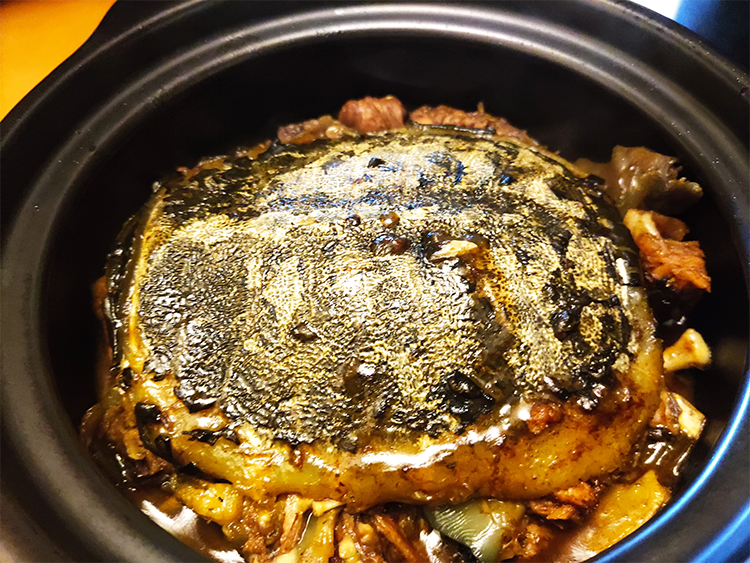Ningbo Braised Eel: Pan-Fragrant Eel of Zhejiang
1. Zhejiang Bingtang Soft-Shelled Turtle: Ningbo’s “Du Zhan Ao Tou” Delicacy
“Daida” isn’t dull — it’s delicious. When you visit Ningbo in Zhejiang province, don’t miss one of its most celebrated traditional dishes: Bingtang soft‑shelled turtle, also known as “Du Zhan Ao Tou” (literally “seizing the top of the Ao”). A staple among Ningbo’s top ten signature dishes, this slow‑stewed delicacy glows golden, has a tender, silky texture, and balances sweet, sour, savory, and aromatic notes. Rich in protein, iodine, and iron, it’s prized both for flavor and nourishing benefits. Let’s explore its history, meaning, ingredients, cooking method, and how to enjoy it like a local.
2. Origins and History: A Qing‑Era Celebration Dish
Bingtang soft‑shelled turtle traces its popularity back to the Qing dynasty. Ningbo’s role as a busy trading port helped create a diverse and refined culinary culture. Turtle meat—tender and nutritious—was often reserved for special celebrations. The bingtang (rock sugar) preparation likely developed as Ningbo chefs experimented with combining sweet and savory flavors. Legend says the dish was first made to celebrate scholars who passed imperial exams; because the turtle’s shape resembles the mythical “Ao,” the name “Du Zhan Ao Tou” was adopted as a blessing for success. Ever since, the dish has featured at banquets, weddings, and festive tables.

3. Cultural Meaning: Luck, Longevity, and Culinary Craft
In Chinese symbolism the soft‑shelled turtle represents longevity and resilience, and the phrase “Du Zhan Ao Tou” symbolizes triumph and honor. Serving Bingtang turtle at important gatherings expresses best wishes for a prosperous future. More than symbolism, the dish reflects Ningbo’s culinary philosophy: elevating simple ingredients through careful technique to create food that pleases the eye, nose, and palate. It’s cookware wisdom and cultural meaning combined.
4. Ingredients: The Perfect Match of “Daida” and Rock Sugar
The main ingredient is the soft‑shelled turtle—affectionately called “daida” by locals because it often remains still when caught, as if pondering life. Ningbo supplies high‑quality turtles with full, flavorful meat. Rock sugar is essential: it lends sweetness and a glossy sheen. Common seasonings include sliced ginger, spring onions, Shaoxing wine (or yellow wine), light soy sauce, and a touch of vinegar to balance the sweetness. Choosing fresh turtle and quality rock sugar is key to the dish’s multi‑layered taste.

5. Cooking Method: The Art of Slow Simmering
Making Bingtang turtle requires patience. First, clean and cut the turtle, then blanch briefly to remove any fishy odor. Heat oil in a pan, sauté ginger and scallion until fragrant, and lightly sear the turtle pieces. Add Shaoxing wine, soy sauce, rock sugar, and enough water to cover. Bring to a boil, then reduce to a gentle simmer for 1–2 hours until the meat is tender and the sauce thickens. Finish by reducing the sauce to a glossy consistency, plate the turtle, and garnish with chopped scallions. Slow simmering allows the turtle to fully absorb the aromatic broth and creates that signature silky texture.
6. Flavor and Texture: A Balanced, Luxurious Bite
Visually, the dish’s bright yellow‑gold sauce entices at first sight. The meat should be soft and almost gelatinous, dissolving pleasantly on the tongue thanks to rich collagen. Flavor layers—rock sugar’s sweetness, soy’s umami saltiness, Shaoxing wine’s depth, and a faint acidity—come together harmoniously. The overall effect is nourishing without being greasy; every mouthful blends history, technique, and regional taste.

7. How It’s Served: A Banquet Centerpiece
In Ningbo, Bingtang turtle often appears as a banquet’s centerpiece. Best served hot with steamed white rice so the sauce can be savored, it also suits communal eating—guests share pieces while enjoying the convivial atmosphere. Because turtle is richly nutritious, many locals favor it in autumn and winter as a restorative dish. Its presence on the table signals celebration, unity, and good fortune.
8. Tasting Tips: Eat Like a Local
If you’re trying Bingtang turtle for the first time, opt for a reputable, traditional restaurant—examples include Ningbo’s well‑known eateries such as Dongfuyuan or Zhuangyuan Lou, which adhere to classic recipes. Start by sipping a spoonful of the sauce to appreciate its sweet‑savory base, then taste the meat slowly to notice its silky texture. Pairing it with a warm cup of Shaoxing wine complements and cuts through the richness. Don’t miss the tender “skirt” around the shell—locals prize it for its collagen and flavor.

9. Where and When to Try It: Best Places and Seasons
As the birthplace of this dish, Ningbo offers many restaurants serving authentic Bingtang turtle, especially in the old town and waterfront areas. The best season is autumn and winter when turtles are plump and flavorful. Popular dining districts like Tianyi Square and Lao Waitan (Old Bund) host traditional establishments. Prices vary by size and restaurant class—expect roughly RMB 200–500 per turtle in many places. Because preparation takes time, reserve ahead during busy festival periods to avoid waiting.
10. Simple Home Version: Recreating Ningbo at Home
You can try a simplified home recipe using pre‑cleaned turtle pieces: blanch the pieces and set aside. Sauté ginger and garlic in oil, add the turtle and stir briefly. Add about 2 tablespoons soy sauce, 1 tablespoon Shaoxing wine, 50 g rock sugar, and enough water to cover. Bring to a boil, then simmer on low for about one hour until the meat is tender and the sauce reduces. Finish with a quick high‑heat glaze. While a home version won’t fully replicate a traditional slow‑stewed restaurant preparation, it captures the core sweet‑savory profile.

11. Conclusion: A Ningbo Treasure Worth Tasting
Bingtang soft‑shelled turtle is more than a regional specialty—it’s a cultural emblem combining Qing‑era history, auspicious symbolism, nourishing qualities, and refined cooking. From its “Du Zhan Ao Tou” meaning to its glossy rock‑sugar glaze and silky texture, the dish embodies Ningbo’s culinary soul. If you travel to Ningbo, sample this age‑old tonic delicacy—it’s a flavorful way to connect with local tradition and leave with a memorable taste of Zhejiang.


